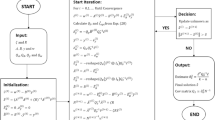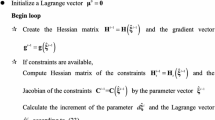Abstract
A new approach to the determination of least-squares solutions for the rank deficient model is presented, which, in place of the classical minimal constraints, utilizes the expression of the excess parameters as a function of a subset of unknown parameters describing the model without ambiguities. The role of the lack of reference system definition in the resulting rank deficiency is explained, first for the original non-linear model case, and is specialized next to the linearized model. The whole set of solutions is parameterized in terms of two matrices defining the linearized relation from the model describing parameters to the remaining ones. Particular values are obtained for the case of solution with minimal trace of its covariance matrix, as well for the solution for minimum norm. Finally, the connection with the existing classical approach is established, while the approach is further elaborated in terms of the full-rank decompositions of the model design matrix.


Similar content being viewed by others

References
Baarda W (1995) Linking up spatial models in geodesy. Extended S-Transformations. Netherlands Geodetic Com-mission, Publ. in Geodesy, New Series, no. 41, Delft
Biagi L, Sanso F (2003) Sistemi di riferimento in geodesia: algebra e geometria dei minimi quadrati per un modello con deficienza di rango. Bollettino di Geodesia e Scienze Affini. Parte prima: Anno LXII, N. 4, 261-284. Parte seconda: Anno LXIII, N. 1, 29–52. Parte terza: Anno LXIII, N. 2:129–149
Bjerhammar A (1951) Rectangular reciprocal matrices with special emphasis to geodetic calculations. Bull Géodésique 52:188–220
Blaha G (1971) Inner adjustment constraints with emphasis on range observations. Department of Geodetic Science, Report 148, The Ohio State University, Columbus
Blaha G (1982) Free networks: minimum norm solution as obtained by the inner adjustment constraint method. Bull Géodésique 56:209–219
Dermanis A (1995) The nonlinear and space-time geodetic datum problem. In: Intern. Meeting “Mathematische Methoden der Geodäsie”, Oberwolfach, 1–7 Oct. 1995. http://der.topo.auth.gr/
Dermanis A (1998) Generalized inverses of nonlinear mappings and the nonlinear geodetic datum problem. J Geodesy 72:71–100
Dermanis A (2000) Establishing global reference frames. Nonlinear, temporal, geophysical and stochastic aspects. In: Sideris M (ed) Gravity, geoid and geodynamics 2000, p. 35–42, IAG Symposia, vol. 123, Springer, Heidelberg 2001
Dermanis A, 2003. The rank deficiency in estimation theory and the definition of reference frames. In: Sansò F (ed) V Hotine-Marussi Symposium on Mathematical Geodesy. IAG Symposia 127, pp 145–156. Springer, Berlin
Dermanis A (2016) Global reference systems: theory and open questions. invited paper at the academia dei lincei session, In: VIII Hotine-Marussi symposium on mathematical geodesy, Rome, 17–21 June, 2013. Sneeuw N, Novák P, Crespi M, Sansò F (eds): VIII Hotine-Marussi Symposium on Mathematical Geodesy, IAG Symposia, vol 142, pp 9–16. Springer International Publishing, Switzerland
Grafarend E, Schaffrin B (1974) Unbiased free net adjustment. Surv Rev 22(171):200–218
Grafarend E, Schaffrin B (1976) Equivalence of estimable quantities and invariants in geodetic networks. Zeit-schrift für Vemessungswesen 101(11):485–491
Koch K-R (1999) Parameter estimation and hypothesis testing in linear models, 2nd edn. Springer, Berlin
Meissl P (1962) Die innere Genauigkeit eines Punkthaufens. Österreichers Zeitschrift für Vermessungswesen, 50, 159–165 and 186–194
Meissl P (1965) Uber die innere Genauigkeit dreidimensionalern Punkthaufen. Zeitschrift für Vermessungswesen, 1965, 90. Jahrgang. Heft 4:109–118
Meissl P (1969) Zusammenfassung und Ausbau der inneren Fehlertheorie eines Punkthaufens. Deutsche Geodät. Komm. Reihe A Nr 61:8–21
Penrose R (1955) A generalized inverse for matrices. Proc Cambridge Philos Soc 51:406–413
Rao CR (1973) Linear statistical inference and its applications, 2nd edn. Wiley, New York
Author information
Authors and Affiliations
Corresponding author
Appendices
Appendix A: Derivation of the minimum trace of covariance solution
To minimize
where
we need to set
The formal rule for differentials gives
Therefore, the minimization problem can be solved by determining the matrix \( H = H(K) \), such that \( d\phi = {\text{tr}}(H^{T} dK) \), and then solve the equation \( H(K) = 0 \) for \( K. \)
From \( 0 = dI = d(MM^{ - 1} ) = dMM^{ - 1} + MdM^{ - 1} \) follows that \( dM^{ - 1} = - M^{ - 1} dMM^{ - 1} \), and hence,
Consequently
The differential of the target function \( \phi \) becomes
Using the well-known properties \( {\text{tr}}(M^{T} ) = {\text{tr}}(M) \) and \( {\text{tr}}({\text{AB}}) = {\text{tr}}({\text{BA}}), \) we easily arrive at
Comparison with (48) shows that
and since \( \det Q_{0} \ne 0 \), the solution system \( H(K) = 0 \) reduces to
which is obviously satisfied by
To assess the uniqueness of this solution, we transpose and rearrange (55) into
Solving for \( \varGamma \) yields
and upon using the easy to prove matrix identity \( (I + KK^{T} )^{ - 1} = {\rm I} - {\rm K}(I + K^{T} K)^{ - 1} K^{T} \)
Appendix B: Derivation of the minimum norm solution
The target function to be minimized is as follows:
where also \( x_{0} \) depends on \( K \) and \( k \) through \( x_{0} = (I + \varGamma K)^{ - 1} N_{0}^{ - 1} (u_{0} - N_{0} \varGamma k) \). Taking into account that
where \( e_{j} \), \( \varepsilon_{i} \) are vectors with elements \( (e_{j} )_{k} = \delta_{jk} \) and \( (\varepsilon_{i} )_{k} = \delta_{ik} \), we compute first the partial derivatives
To obtain the minimum norm solution, we must set the derivatives of the target function \( \phi \) with respect to the vector \( k \) and all elements of the matrix \( K \) equal to zero. For the elements of \( K \), we obtain
which for all \( i \) and \( j \) leads to
From \( x_{0} = (I + \varGamma K)^{ - 1} N_{0}^{ - 1} (u_{0} - N_{0} \varGamma k) \) follows that \( (u_{0} - N_{0} \varGamma k) = N_{0} (I + \varGamma K)x_{0} \), which replaced above gives
For the elements of \( k \), we obtain
Thus, the minimum norm solution is obtained for the values of \( K \) and \( k \), which satisfy the system
It is easy to see that this system is satisfied by \( K = \varGamma^{T} \) and \( k = 0. \) Indeed, for these values, the right-hand side of (B11) becomes
while the right-hand side of (B12) becomes
and this completes the proof.
Appendix C: Proof of equivalence of new and classical solutions
Since the minimum trace and the minimum norm solutions are simply special cases (\( C \to E \),\( k \to 0 \)) of the general least-squares solution, we need to prove the equivalence of new and classical formulas only for the general case.
To compare the new and classical old solution, which we will now symbolize with \( \hat{x}_{\text{NEW}} \) and \( \hat{x}_{\text{OLD}} \), respectively, for the sake of distinction, we will rewrite (4) in the form
Instead of comparing (73) with the classical solution
we will multiply them both from the left with the same non-singular matrix \( (N + CC^{T} ), \) and we will compare instead
with
To this purpose, we note that
and
while recalling that \( K = - C_{c}^{ - T} C_{0}^{T} , \) \( k = C_{c}^{ - T} d, \) \( \varGamma = - E_{0} E_{c}^{ - 1} \)
Considering the above relations, direct calculation gives
Noting that (77) and (81) imply the well-known relation \( NE = 0, \) we obtain
Which, in view of (78), becomes
Comparing (82) with (84), it follows that \( (N + CC^{T} )\hat{x}_{\text{NEW}} = (N + CC^{T} )\hat{x}_{\text{OLD}} \), and hence, \( \hat{x}_{\text{NEW}} = \hat{x}_{\text{OLD}} , \) which proves the equivalence of the two solutions.
Rights and permissions
About this article
Cite this article
Dermanis, A., Sansò, F. Different equivalent approaches to the geodetic reference system. Rend. Fis. Acc. Lincei 29 (Suppl 1), 11–22 (2018). https://doi.org/10.1007/s12210-017-0650-y
Received:
Accepted:
Published:
Issue Date:
DOI: https://doi.org/10.1007/s12210-017-0650-y



